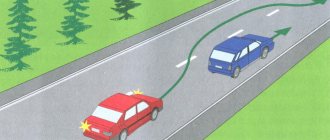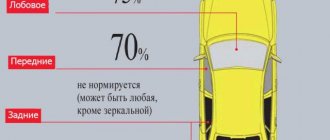In Russia, there are several laws prohibiting the application of dark film to car windows. Despite this, many car owners neglect the requirement to “decorate” their car in this way.
To radically change the situation and force drivers to comply with the rules, the authorities introduced a fine for tinting in 2021. According to the new law, the punishment will be significant, but you can find out how much the fine can be from the article.
What is the fine for tinting in 2021 according to the new law?
Until recently, a fine of 500 rubles was imposed for tinting that did not meet state standards. When it came to a repeated violation, the fine increased to 1000 rubles. After the introduction of new requirements for the placement of tinting film, the amount of the monetary penalty was not revised. A year later, State Duma deputies proposed an initiative to tighten penalties for violating the requirements of regulatory documents.
According to the information presented in the document, the following punishments were envisaged for the offense:
- 1500 rubles – for drawing up a protocol for the first time;
- 5000 rubles – repeated fine for tinting;
- deprivation of rights for 2-6 months – in case of triple violation.
Subsequently, the deprivation of military rights was removed, and the bill was adopted. In the new law, the fine for tinting in 2021 was also 500 rubles. The information was valid as of January 1, 2021, although the fine was planned to increase in the future. Such provisions have been introduced in the new bill. Today the document is already in force and from January 1, 2021, citizens will be required to pay a fine in a larger amount.
Important! If the penalty has not been paid within 70 days from the date of its imposition, the driver will be responsible in a different way. In addition to 1000 rubles, compulsory work (50 hours) or arrest - 15 days may be imposed.
Actions of a traffic police officer upon detection of tinted windows
In 2021, a traffic police officer is obliged to act within the framework of Federal Law No. 3 of February 7, 2011 “On the Police,” and also comply with the requirements of Order of the Ministry of Internal Affairs of the Russian Federation No. 664 of August 23, 2021. The inspector has the right:
- in case of legal grounds, stop the vehicle;
- ask the driver to show the documents reflected in paragraph 2.1.1 of the Russian Traffic Regulations;
- initiate a measurement of the light transmittance of the glass if it visually appears that they are tinted;
- draw up a protocol on an administrative offense if a violation is detected.
Along with the fine, an order to remove the tint is often issued. However, such an action is considered illegal. The fact is that tinted car windows themselves are not an offense. Article 12.5 of the Code of Administrative Offenses of the Russian Federation states that punishment is imposed for driving a car on which glass is installed that does not meet the requirements of the Technical Regulations of the Customs Union. Therefore, the traffic police representative, in accordance with this article, does not have the right to force the driver to remove the tint.
Since the order is issued by the traffic police officer on the basis of Article 29.13 of the Code of Administrative Offences, it can only be issued to legal entities. When filling out an order for an individual, the inspector commits a violation of the Code of Administrative Offenses of the Russian Federation. In practice, traffic police officers issue demands to individuals; if such an action is appealed, the court generally takes the side of the police officers.
In practice, traffic police officers can still issue an order and force the driver to remove the tint. However, the document does not record a request to bring the glass in accordance with light transmittance standards, but an obligation to stop the violation. Such a right is fixed in Article 13 of the Federal Law “On the Police”.
In this situation, a citizen can take the following actions:
- remove the tint and continue driving without hindrance;
- stop driving the vehicle.
Failure to comply with the order entails liability under Part 1 of Article 19.3 of the Code of Administrative Offenses of the Russian Federation. If a person does not obey a lawful order or requirement of a police officer, the person will face an administrative fine in the amount of 500-1000 rubles or arrest for failure to remove tinting for up to fifteen days. The judge chooses the type of punishment.
Details of the new bill
The law on car tinting was adopted back in 2021. In the future, it was planned only to make changes to this document. The basic provisions will remain the same, except that the amount of penalties will increase.
This decision was dictated by the fact that drivers perceive a small fine as a minor problem. As a result, traffic violators pay 500 rubles and continue to drive tinted cars. In turn, tinting can cause an emergency. The new law on tinting of 2021 suggests that the amount of the penalty will increase to 1,500 and 5,000 rubles. According to the latest news in this topic, issuing fines in the new amount has become possible as of January 1, 2021.
What to do with tinting?
Once they find out whether their license can be revoked for tinting, drivers will have to think about what to do. Tighter legislation will lead to temporary loss of driver's license. Such results will certainly make you reconsider your own view of travel. No one wants to give up their vehicle, so it’s better to foresee an unpleasant outcome in advance.
It is most practical to remove the film and get maximum visibility on the road. After which you will not have to worry about a possible collision with traffic police inspectors. They will not even have grounds to issue a fine. Because of this, not only safety and peace of mind will appear while traveling. Yes, not all drivers have yet come to this opinion, but it should be called the only correct one.
Light transmittance of glass tinting
Deprivation of rights begins to apply to various offenses. Now their list is gradually being replenished with new reasons, so it needs to be studied so as not to encounter danger. If you know exactly the possible actions of the state traffic police, you will be able to prepare for them and protect yourself from unpleasant consequences. The absence of violations will exclude punishment, which is the right choice for a person who prefers personal transport.
Tinting standards according to GOST
Not everyone knows what requirements for tinting in 2021 apply to drivers. In order not to become a victim of abuse of power by the traffic police officer, it is worth carefully studying what the tinting should be on the car and on each of the windows. According to the current regulations, the standards are as follows:
| Light transmittance | Car glass type |
| from 70% | Windshield |
| from 70 | Front side windows (for armored ones - up to 60%) |
| not regulated | Rear window visibility. The use of mirror type film is prohibited. |
| up to 14 cm | Protective light strip on the windshield, in the upper part. |
Based on these standards, you can tint your car yourself and not worry that if you are stopped by traffic police, you will have to “excuse yourself” and pay a fine.
Normative base
Previously, the issue of imposing a fine for tinting was regulated by GOST 5727 88. Paragraph 2.2.4 stated that the light transmittance of vehicle windshields should be at least 75%. For all other glasses, a minimum of 70% was applied.
On January 1, 2015, the regulatory legal act lost force. It was replaced by GOST 32565-2013. It established a single threshold for light transmittance, which was 70%.
Additionally, the Technical Regulations of the Customs Union were adopted. It also came into force on January 1, 2015. The issue of light transmittance of vehicle windows is reflected in Art. 4 of the above-mentioned legal act. The technical regulations state that a fine for tinting is permissible if the light transmittance of the windshield and front windows is less than 70%. In this case, the rear window can be darkened if a rear view mirror is present.
Experts recommend familiarizing yourself with the provisions of Article 12.5 of the Code of Administrative Offenses of the Russian Federation. It regulates the penalties that can be imposed for non-compliance with glass light transmittance standards in 2021.
What tint can be applied to front windows in 2021?
Special requirements apply to tinting front windows. In addition to the fact that they must have a sufficient level of light transmittance, there are several more nuances that must be observed:
- It is prohibited to cover the windshield with films of different colors and shades.
- You cannot cover the entire windshield.
- SP80 and 90 films are prohibited for use.
The current law describes other, smaller requirements for tinting, but it is also advisable to familiarize yourself with them.
What is a tint prescription?
An authorized person has the right not only to stop the car and check the condition of the tint, but also to issue a special document - an order. This form contains a requirement regarding how long the driver must remove the tint.
If the violator for any reason does not correct the situation, then the next time he is detained he will have to pay a fine of 1,500 rubles or arrest for 10-15 days.
What to do if he was discharged?
After the order is drawn up and handed over to the violator, the driver has only two options - to prove that the requirement is unlawful or to get rid of the tint. The problem is that to confirm that you are right, you will need to order a special examination on the light transmittance of the tint. The cost of such a service is not the smallest. If no action is taken, then the probability of not receiving a fine is very, very high.
Is this legal?
Regarding windshields, the requirements are quite clear and categorical. It's not so bad with the rear windows. Today there are no standards that do not allow completely tinting the windows in the car body.
The only problem that drivers should be aware of is that it is prohibited to dim the mirrors and headlights. When checking, you must take standard measurements.
Attention! The test is performed only during daylight hours and at normal humidity levels. If this rule has been violated, the results of the inspection can be easily challenged.
Driver actions when tinted windows are detected
If a car is stopped for an inspection, at the request of a traffic police officer, the driver is obliged to present the documentation reflected in clause 2.1.1 of the Russian Traffic Regulations. The citizen must comply with the inspector’s instructions, which do not contradict the norms of current legislation. In another situation, a person may be prosecuted under Article 19.3 of the Code of Administrative Offenses of the Russian Federation. Disobedience entails a fine of 500-1000 rubles or administrative arrest for up to 15 days.
If a representative of the State Traffic Inspectorate does not have a device that allows you to measure the light transmission of glass, and the inspector suggests that the citizen go to the nearest checkpoint for inspection, the person is not obliged to perform the action. The fact is that for this purpose administrative detention must be carried out. The process is regulated by Article 27.3 of the Code of Administrative Offenses of the Russian Federation. It states that administrative detention is a short-term restriction of the freedom of an individual. The measure can be applied only in exceptional cases, if it is required for the correct and timely consideration of a case of an administrative offense or the execution of a decision. If the detention is not carried out, the inspector does not have the right to oblige the driver to go with him.
How long does the order last?
Within 70 days after issuing a fine, the offender is obliged to pay the debt. Otherwise, I will hold him accountable and will assign an additional amount to pay - 5,000 rubles. When the driver is unable to pay or refuses to do so, the judge may impose mandatory work or an administrative fine.
Attention! When a car owner violates the rule more than 12 times in a year, he may face a more serious punishment in the form of deprivation of his license.
Can it be appealed?
The issued fine can be appealed if the citizen has official evidence indicating that the prosecution was carried out without legal grounds. The decision can be appealed exclusively in court.
How many fines can be issued?
At least a hundred every day. This is in practice for 2021. In fact, it is possible to appeal repeated fines on the same day, for example, quite successfully. The thing is that you are essentially not a specialist and you don’t have the opportunity to just rip off the film. Well, that is, the judges believe in this and quite reasonably.
Yes, according to the letter of the law, each start of movement in your case forms a new offense (remember, a fine is imposed specifically for driving with tinting?). And in principle, the same inspector who has already stopped and fined you can then move a couple of meters in front and stop you again with the same violation and issue a new ruling. However, each subsequent fine in this case will be illegal precisely because you are not guilty of the new violation. Although, here too, some judges can assure you that you were obliged to call a tow truck, and it is your own fault.
Reasons for imposing fines for tinting
Monetary penalties are imposed only for violation of the tinting standards previously described in the article. When a traffic police inspector imposes a monetary penalty, he must indicate in the protocol the reason for such a decision.
Today I'm fined for tinting motorcycles. Despite the fact that the technical means does not look dangerous, traffic police officers do not think so and punish motorists.
Important! Article 29.13 of the Code of Administrative Offenses of the Russian Federation states that a fine can only be imposed on citizens. Such punishment is not provided for legal entities.
How and where is light transmittance checked?
Inspection of the technical condition of a vehicle is strictly regulated by relevant laws and regulations. Order of the Ministry of Internal Affairs No. 1240, which until recently regulated the inspection of tinting, has been cancelled. Traffic police officers are guided by Order No. 1123 of the Ministry of Internal Affairs. This document abolished some norms that were in force before it came into force. In particular, we are talking about the right of traffic police officers to remove state registration numbers from cars that have exceeded the tinting standards. It was this circumstance that greatly frightened Russian drivers.
The state registration number is an integral part of the car. If it is missing, the vehicle cannot be operated. Accordingly, the removal of license plates implied the transfer of the car to a penalty area or the inability to further use it. It was quite difficult to collect license plates from the police; to do this, it was necessary to provide convincing evidence that the vehicle was in good condition and that there was either no tinting on the windows at all or that it complied with the requirements established by law. But removing the tint without moving the car is unrealistic. In general, the injured drivers managed to get out as best they could. Many tried to resolve the issue on the spot with the traffic police. And this often implied (to be honest) a significant corruption component. Therefore, there was simply arbitrariness on Russian roads when traffic police officers purposefully stopped almost all cars that had tinted windows. But after the abolition of the rule on removing license plates, the interest of traffic police officers in such car owners fell sharply.
Today's standards allow any police officer, including the traffic police, to check the level of light transmission of glass. The check does not happen by eye, of course. For this purpose, technical diagnostic tools are used, which must have appropriate certificates and also undergo periodic technical testing. Each device is entered into the State Register. The device passport must contain a note about the next diagnostic of its performance. Previously, it was possible to measure the light transmittance of glass only at a stationary post, but now this norm has been abolished - measurements can be carried out anywhere. The light transmittance of car windows is measured only when the glass surface is clean and dry. During rain or on a road dirty from wet snow, it is simply impossible to get accurate readings.
Traffic police officers have the right to check light transmittance, but only according to established rules
If a driver is stopped and traffic police officers want to measure the light transmittance of car windows, then they must insist on presenting the necessary documents: certificates of conformity, technical passport of the device used for diagnostics. Particular attention should be paid to the presence in it of a mark indicating the passage of periodic technical regulations. Police officers must provide permits for such actions. In the absence of any of the above documents, the results of diagnosing the light transmittance of automobile windows will be far from legal.
When checking the light transmittance of car windows, special sensors are attached to them. It is necessary to pay attention to the fact that they do not have artificial darkening and there is no external film on them. When the driver believes that the accuracy of the device is far from ideal, he has the right to request repeated or control measurements. In this situation, traffic police officers must carry out the following measurements in the presence of two witnesses. It is not the driver's responsibility to search for them. Therefore, the police try to stop cars and ask their drivers to act as witnesses. Receiving a request (we emphasize: just a request) from a police officer does not oblige the driver to gladly become an attesting witness. He may refuse, arguing that he is in a hurry to catch a plane, a meeting, work, and so on. Therefore, the police understand that finding a witness on a busy highway is not so easy. Yes, and among drivers there are certain unwritten rules that do not recommend drowning their colleagues, because none of the drivers can be sure that at the next meeting with the State Traffic Inspectorate patrol, he will not become a fellow sufferer. It is clear that finding two witnesses is often problematic. A potential violator is waiting, police officers are looking for witnesses...
If the process drags on and the police do not release the driver, then he has the right to remind them of the existence of Article 28.5 of the Code of Administrative Offenses of the Russian Federation, which considers the long delay of a vehicle by State Traffic Inspectorate officers to draw up a report unlawful. Particularly persistent inspectors may be encouraged to contact their management to clarify the situation. When a driver asks a police officer to provide him with the number of his immediate commander, interest in the driver, as a rule, immediately disappears for some reason. It is also advisable to have with you the hotline numbers of the Ministry of Internal Affairs, where you can voice your complaints about the actions of traffic police officers.
Video about communicating with the traffic police when checking light transmittance
A device for measuring light transmittance and features of its operation
Devices that measure the light transmittance of car windows are called taumeters. Typically police use Blik. It is portable, small in size, and usually works from the cigarette lighter of a stopped car. Therefore, the police ask the driver to connect the device’s plug to the car’s internal network. In this case, the car engine should not run. The device shows reliable operating parameters only when the internal network of the car is not lower than 12 volts. In this case, the driver can justify the impossibility of measurement by informing the traffic police officer that his battery is extremely weak and cannot provide adequate power. In this case, you can safely ask the officer to use the patrol car's battery and electrical system. It is unlikely that police officers will deal with this.
The Blik device is used in the temperature range from -10 to + 40 degrees. Measurements of the light transmittance of automobile glass are carried out at three different points. The arithmetic mean is used as an indicator of light transmission.
When conducting diagnostics, the driver must carefully observe the actions of the inspector. When fixing any error, you don’t have to talk about it. When the traffic police officer begins to draw up a protocol, then in it you need to write your disagreement with the conclusions and justify them with procedural errors made during the measurement of light transmittance. Defending your rights in such a situation is much less problematic. The police can either release the driver or demand a new measurement, but with the participation of two witnesses.
Taumeter is a small device
How to avoid a fine for tinting?
It is worth noting that there are many cars with tinting in Russia. Nowadays you can find vehicles on the street with a variety of tinting options. Not every driver understands that such a car design can be dangerous.
Traffic police officers mainly stop vehicles where the light transmission capacity of the tinting is minimal. Of course, you can give advice that supposedly helps you avoid a fine, but in practice, judges remain on the side of the traffic police officers. To avoid a fine, you must strictly follow the requirements for tinting windows in your car.
Attention! If the driver believes that the fine was issued to him illegally, then he is given 10 days from the date of such decision to appeal.
Why are car windows tinted?
Window tinting has been popular among car enthusiasts for many years. Its practicality lies in the fact that the interior of the car heats up less in the sun; it is not necessary to drive in sunglasses. And there is a common joke among drivers that a tinted car is the key to a happy family. On the roads of the Russian Federation you can find many cars of different categories with tinted windows. Tinting can vary from opaque to just a light coating. About ten or fifteen years ago, the most advanced drivers boasted that their windows were completely covered with a mirror film, blinding not only other drivers, but also pedestrians. But gradually this fashion faded away.
It should be said that the active struggle of the authorities against tinting car windows is predominantly Russian know-how. In the vast majority of other countries, they practically do not fight it. In the United States of America, Canada, Great Britain, Japan, Australia, and New Zealand, you can often see mirror-tinted cars on the roads. The laws of these countries do not prohibit the use of chrome car parts, but they glare in the sun, blinding other drivers. Perhaps such a tolerant attitude in economically developed countries is a tribute to democracy. About ten years ago, the UK authorities tried to ban the tinting of car windows at the legislative level. But this caused a storm of indignation among car owners and taxi drivers. Therefore, it never came to pass the law. The authorities of Ukraine and Belarus long ago passed laws that prohibited mirror tinting of car windows and established standards for regular tinting. But in practice, it turns out that these laws have been forgotten and there is practically no control over their compliance.
Tinted windows are very practical











